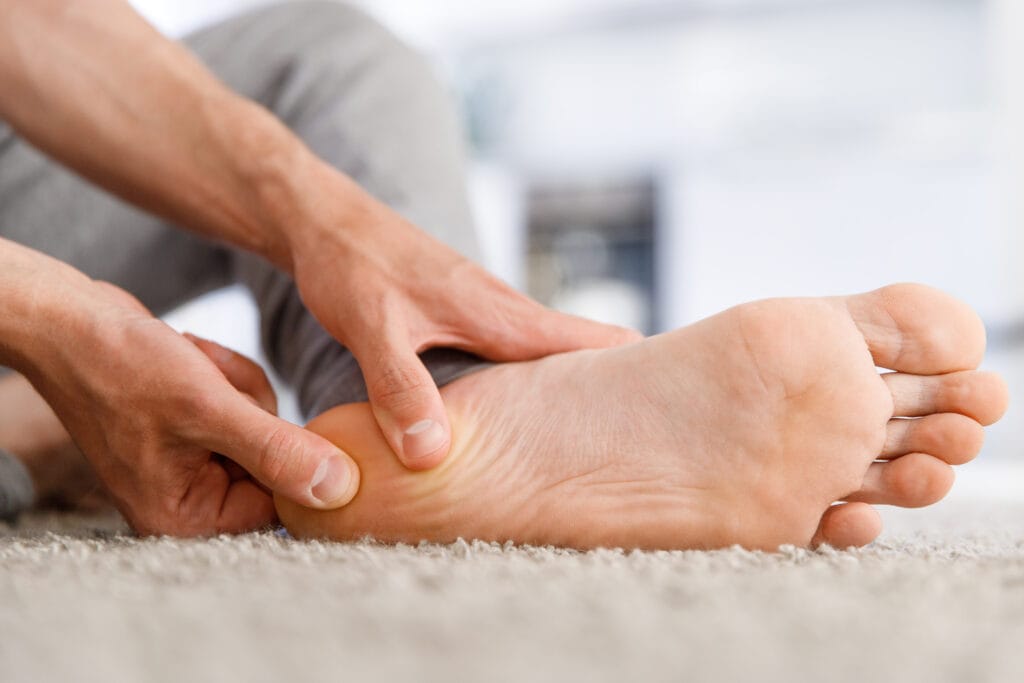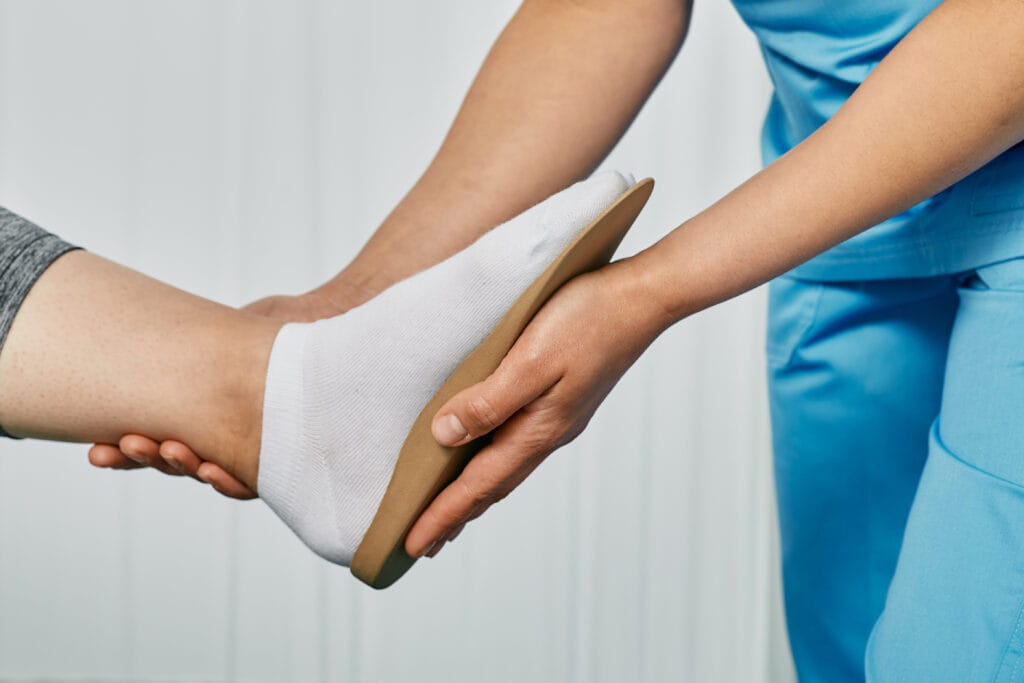
Treatments for plantar fasciitis: Complete and effective guide
Index
Plantar fasciitis is a condition that causes pain in the sole of the foot, especially in the heel. There are several treatments that can help alleviate this discomfort and improve the quality of life of those who suffer from it. Treatments are divided into two categories: non-surgical and surgical. Non-surgical options are the most common and effective, while surgical treatments are considered if the alternatives fail to relieve the pain after a period of time.
Treatments for plantar fasciitis
Addressing plantar fasciitis involves a variety of strategies that can relieve pain and improve foot function. Treatments are divided into non-surgical and surgical approaches, each tailored to the severity of the condition and the patient’s response.
Non-surgical treatments
Rest and reduce physical activity
One of the most effective measures is rest. Limiting activities that generate pain is essential to allow the inflammation to subside. High-impact sports should be temporarily avoided to promote recovery of the foot.
Apply ice to the affected area
Applying ice to the painful area for 15 to 20 minutes, several times a day, helps reduce inflammation and discomfort. It is a simple and accessible technique that can provide immediate relief.
Use of anti-inflammatory drugs
Nonsteroidal anti-inflammatory drugs (NSAIDs), such as ibuprofen and naproxen, are useful in reducing the pain and inflammation associated with plantar fasciitis. It is recommended that you follow your doctor’s instructions regarding their use.
Night splints for foot support
The use of night splints can be beneficial in keeping the plantar fascia and Achilles tendon in a stretched position. This helps prevent morning pain and improves mobility when getting up in the morning.
Surgical treatments
Release of the plantar fascia
When conservative treatments have been unsuccessful after a period of six to twelve months, surgery may be considered. Plantar fascia release involves cutting part of the affected ligament to relieve pressure and pain.
Recession of the gastrocnemius muscles
This surgical intervention seeks to lengthen the calf muscles to improve ankle flexion. It is a procedure that may be necessary in severe cases of plantar fasciitis where conservative treatment has failed.
Exercises and stretches for the plantar fascia
Implementing proper exercises and stretching is essential to improve flexibility and reduce plantar fascia pain. Below are different options that can be performed at home or with the help of a professional.
Basic stretching at home
Performing basic stretches in the comfort of your home can be an effective way to relieve the symptoms of plantar fasciitis. These stretches help to improve muscle elasticity and relax the fascia. Some of them include:
- Calf stretch: Stand in front of a wall and rest your hands on it. With one leg behind you, keep your heel on the floor and bend your front knee.
- Plantar fascia stretch: Sitting, place the affected foot on the opposite knee and gently pull the toes towards the body, feeling the stretch on the sole of the foot.
Exercises to stretch the plantar fascia
There are specific exercises that help improve strength and flexibility in the plantar fascia. These exercises are ideal to incorporate into your daily routine:
- Foot roller: Use a roller or a bottle of cold water to massage the sole of the foot, rolling from back to front.
- Heel raises: Standing, raise the heels while balancing on the tips of the toes, holding for a few seconds and slowly lowering.
Exercises with the help of a physiotherapist
Having a physical therapist can be beneficial for more advanced and personalized exercises. These professionals can design an exercise program focused on specific needs:
- Resistance exercises: Use elastic bands to strengthen the foot and calf muscles.
- Mobilization techniques: Employ manual techniques to increase mobility and reduce tension on the plantar fascia.
Home treatments for pain relief
There are several natural options that can help mitigate the pain associated with plantar fasciitis. These home remedies are complementary to medical treatments and can offer effective relief at home.
Foot massagers
The use of foot massagers is an effective technique for relaxing muscles and reducing tension in the plantar fascia. These devices may vary in design and functionality, but all share the goal of relieving discomfort by stimulating specific points on the feet.
Different types of massagers are available, such as manual massagers, which allow for more personal control, or electric massagers, which provide an effortless, even massage. Spending 10 to 15 minutes with a massager can improve blood circulation and decrease pain.
Health and prevention tips
Implementing certain health habits can contribute significantly to plantar fasciitis pain relief. A preventive approach can be key to avoiding recurrence of this condition.
- Performing gentle stretches before and after physical activities helps maintain flexibility of the foot and calf muscles.
- Applying a warm towel or warm water bag to the affected area can relax the muscles and facilitate pain relief.
- It is advisable to maintain adequate hydration, since water is essential for tissue health.
- Incorporating a balanced diet that includes anti-inflammatory foods, such as fresh fruits and vegetables, can have positive effects on overall foot health.
- Getting sufficient rest and avoiding excess weight are also measures that impact pressure on the plantar fascia.
Appropriate footwear and insoles
The choice of footwear and the use of appropriate insoles are critical to the management of plantar fasciitis. Good support can relieve pressure on the fascia and prevent aggravation of symptoms.
Recommended type of footwear
Appropriate footwear plays an essential role in the prevention and treatment of plantar fasciitis. Features to look for include:
- Arch support: Shoes should offer good support for the arch of the foot, which helps distribute pressure evenly.
- Cushioning: A shoe with good cushioning absorbs the impact of walking, reducing heel and arch pain.
- Stiff sole: It is recommended that the sole be stiffer to avoid excessive flexion of the foot when walking.
- Proper sizing: Footwear should fit snugly, without being too tight or too loose, to avoid chafing and injury.

Orthopedic Insole and its use
Insole orthotics for plantar fastis can be a great help. They are designed to conform to the anatomy of the foot, offering additional support where it is needed most. Using these Inoles can improve alignment and reduce stress on the plantar fascia.
There are different types of Insole:
- Custom Insole: These are manufactured specifically for each patient, providing exact support based on their biomechanics.
- Prefabricated Inoles: Available in stores and pharmacies, these are a more affordable option and can offer relief for many users.
The correct use of Insole, combined with appropriate shoes, can result in significant symptom relief, promoting recovery and overall foot comfort.
Use of advanced therapies
Advanced therapies have emerged as effective alternatives to treat plantar fasciitis, especially in those cases where conventional treatments have not provided the expected relief.
Extracorporeal shock waves
This innovative treatment uses pulses of acoustic energy to stimulate the healing process in the plantar fascia. The shock waves promote tissue regeneration by increasing blood flow and promoting cellular repair. This method has been shown to be effective in reducing pain and improving foot function, especially in patients with persistent symptoms.
Advanced physical therapy with specialists
Physical therapy with a specialized professional is crucial to address plantar fasciitis from a comprehensive approach. This therapy may include manual techniques, specific exercises and the use of modern equipment to facilitate recovery. Physical therapists can design individualized programs that are tailored to the patient’s needs.
- Structured exercise programs that promote foot mobility and strength.
- Manual therapy techniques that can relieve tension in the plantar fascia and related muscles.
- Implementation of advanced technologies, such as ultrasound and electrotherapy, which aid in recovery.
Collaboration with a physical therapy specialist not only improves recovery, but also reduces the risk of relapse. It is crucial to follow the indications and guidelines set by the therapists for an effective recovery.
Prevention of plantar fasciitis
Implementing preventive measures is critical to reducing the risk of developing plantar fasciitis. Attention to certain habits and practices can make a difference.
Tips for preventing plantar fasciitis
There are several recommendations that can help prevent the onset of this condition. Some of the most relevant are:
- Proper footwear: Choosing shoes that offer support and cushioning is essential. Avoid shoes that are too flat or worn out.
- Control and maintain a healthy weight: Excess weight can increase pressure on the plantar fascia, so a balanced diet and exercise are crucial.
- Variation in activities: Alternating between different types of exercises can help avoid overuse of the same muscle group and foot structures.
- Stretching: Incorporating stretching exercises before and after physical activities helps maintain flexibility and plantar fascia health.
Importance of maintaining a healthy weight
Weight control is a key aspect of overall foot health. Excessive weight can not only lead to plantar fasciitis, but also to other joint and muscle problems. Maintaining an active lifestyle along with a balanced diet will help reduce the load on the feet with each step.
Diagnosis and medical care
Diagnosis of plantar fasciitis is a critical step in receiving appropriate treatment. Medical evaluation allows the severity of the condition to be identified and an effective management plan to be developed.
How diagnosis can guide treatment
The physician will perform a series of steps to diagnose plantar fasciitis. First, a thorough physical examination will be performed, including:
- Review of the patient’s medical history.
- Evaluation of foot mobility and tendon flexibility.
- Identification of specific pain points on the sole of the foot.
In some cases, additional tests such as x-rays or ultrasound may be ordered. These images help to rule out other similar conditions, such as fractures or periostitis. The information gathered in this process will inform decisions regarding non-surgical or surgical treatment, if deemed necessary.
When to seek professional medical care
It is advisable to consult a health professional if the pain persists, intensifies or affects daily activities. Some warning signs are:
- Pain that does not improve after periods of rest.
- Symptoms that worsen over time.
- Inability to walk or perform daily activities.
Seeking prompt and specialized medical attention can facilitate a more effective recovery and contribute to improving the patient’s quality of life. Thus, long-term complications can be avoided and proper management of the condition can be ensured.
Did you like this content? Share it on your social networks:

